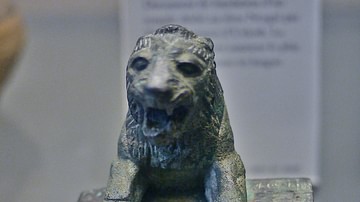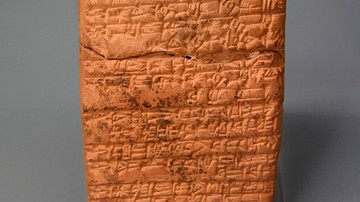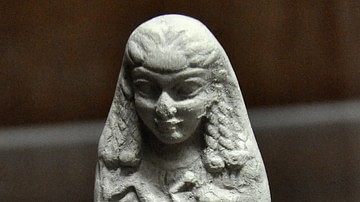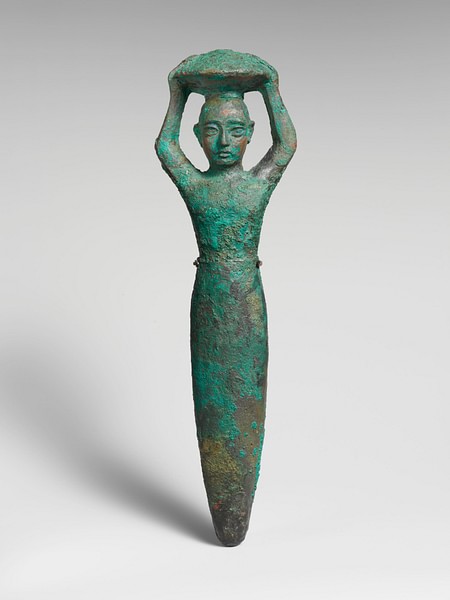
Shulgi of Ur (r. 2029-1982 BCE) is considered the greatest king of the Ur III Period in Mesopotamia (2047-1750 BCE). His father was Ur-Nammu (r.2047-2030 BCE), who founded the Third Dynasty of Ur, and his mother was a daughter of King Utu-Hegal of Uruk (her name is not known) who first led the uprising against the Gutian occupation.
Shulgi (also known as Culgi, Dungi, and Sulgi) inherited a stable kingdom after his father was killed in battle with the Gutians and proceeded to build upon his father's legacy to raise Sumer to great cultural heights. A literate man, he reformed the scribal schools and increased literacy throughout the region (among his greatest accomplishments) while also encouraging developments in musical performance as he was an accomplished musician.
He allocated funds for the continued maintenance of the cities, improved the existing roads and built new ones, and even instituted the first roadside inns so that travelers could stop, rest, eat, and drink as they traveled (an innovation later adopted by the Persian Achaemenid Empire, c. 550-330 BCE). He also either instituted or continued the law code named for his father, the Code of Ur-Nammu, the oldest extant law code in the world. He declared himself a god during his lifetime and seems to have been worshipped by the people following his death.
His reign is well documented as he had many scribes making inscriptions of his accomplishments but this documentation has been challenged on the grounds of inaccuracy. While it does seem clear that Shulgi reigned well, the majority of the documents relating to the details of his rule were those he ordered to be set down, including the famous A Praise Poem of Shulgi. Later chroniclers would accuse him of impiety and falsification of records, but the archaeological evidence seems to support his version of his reign fairly well. He is regularly credited with either initiating or encouraging the rebirth of Sumerian culture known as the Sumerian Renaissance.
Early Reign & Shulgi's Run
Ur-Nammu's rule had stabilized the region and enabled it to prosper following the expulsion of the Gutians and, thanks to the poem The Death of Ur-Nammu and His Descent to the Underworld, he had become an almost mythic hero shortly after his death.
His successor might be expected to have struggled to distinguish himself from the former's rule, but this does not seem to be the case with Shulgi. In order to ensure the stability of his kingdom, he created a standing army which he formed into specialized units for specific military purposes. An infantryman was no longer just a `foot soldier' but specialized in a certain tactic, formation, and purpose on the field.
Once formed and trained, he then drove this army against the remaining Gutians in the region to avenge his father's death and secure the borders. To raise money for his army, he initiated the unprecedented policy of taxing the temples and temple complexes which, though it may have made him unpopular with the priests, could have bolstered his popularity among the general populace who did not have to suffer an increase in taxation.
Scholar Stephen Bertman notes that, "Ur-Nammu's imperialistic dreams were fulfilled by his son Shulgi” in the expansion of the Kingdom of Ur from southern Mesopotamia near Eridu up the Tigris River valley to Nineveh in the north (57). This area corresponds roughly to modern-day Kuwait in the south to northern Iraq. The kingdom was maintained efficiently through the unified central administration instituted by Ur-Nammu, which Shulgi improved upon, and was protected and enlarged by the standing army which, since it needed no mobilization, could respond quickly to any disturbance on the borders. With his state secure, Shulgi could devote himself to encouraging art and culture, as his father had done.
He introduced a national calendar and standardized time-keeping so that the whole of his kingdom recognized the same day and time, replacing the old method of different regions reckoning dates and times in their own way. He also instituted agricultural reforms and standardized weights and measures to ensure fair trade in the market place. Prior to Shulgi's reforms, prices varied – sometimes widely – between trade goods in Ur and the same goods in Nippur. All documents were written in Sumerian (instead of the traditional state language, Akkadian), perhaps in an effort to differentiate Shulgi's reign from those of the past.
Even so, he seems to have purposefully presented himself to his subjects as a new Naram-Sin (r. 2261-2224 BCE) of Akkad, the last great ruler of the Akkadian Empire. Ur-Nammu had also understood the value of linking his reign to that of the legendary Akkadian kings, but Shulgi went further in proclaiming himself a god, as Naram-Sin had also done, and signing his name to documents with the divine determinative.

While his accomplishments were many, he still seems to have felt that he was merely carrying on the policies and building projects instituted by his father. Scholar Paul Kriwaczek writes:
Construction work on Ur-Nammu's ziggurats continued well into his son's reign, which left Shulgi with the problem of how to establish his own superhuman persona in his people's awareness. He chose to run. (156)
In a single day, Shulgi ran from Nippur to Ur, a distance of 100 miles (160.9 kilometres), in order to officiate at the religious festivals in both cities, and then ran back from Ur to Nippur; completing a run of 200 miles (321.8 kilometres) in one day. His motivation in making the run is made clear in one of his best-known inscriptions, A Praise Poem of Shulgi:
So that my name should be established for distant days and never fall into oblivion, that it leave not the mouth of men,
That my praise be spread throughout the land,
That I be eulogized in all the lands,
I, the runner, rose in my strength, all set for the course
From Nippur to Ur,
I resolved to traverse as if it were but a distance of one `double-hour'
Like a lion that wearies not of its virility I arose,
Put a girdle about my loins
Swung my arms like a dove feverishly fleeing a snake,
Spread wide the knees like an Anzu bird with eyes lifted toward the mountain. (Lines 36-45; Kramer, 286)
The run certainly accomplished its objective, since Shulgi was associated with the event, and with great stamina, in later chronicles. His courage and determination were also praised because his run took place in the midst of a terrible storm. The Praise Poem continues:
On that day the storm howled, the tempest swirled/The North Wind and the South Wind roared violently/Lighting devoured in heaven alongside the seven winds/The deafening storm made the earth tremble. (Lines 60-63; Kramer, 287)
So famous, in fact, did Shulgi become for his run that he became a popular figure featured in erotic poetry throughout Mesopotamia not long afterwards and was noted for his virility and stamina as the lover of the goddess Inanna. Regarding the famous run, Kriwaczek writes:
Could he really have done it? An earlier generation of Assyriologists thought the achievement impossible, dismissing it as fiction. More recent consideration, however, suggests otherwise. An article in the Journal of Sport History quotes two relevant records: `During the first forty-eight hours of the 1985 Sydney to Melbourne footrace, Greek ultra-marthoner Yannis Kouros completed 287 miles. This impressive distance was accomplished without pausing for sleep.' In the 1970's a British athlete running on a track completed 100 miles in a time of eleven hours and thirty-one minutes. There is no reason to believe that the Sumerians were any less athletically able. Theirs was, after all, a far more physical world than is ours: speed, strength, and stamina would have been much more important to them that they are to us. (157)
Shulgi's run spread his fame across the land, as he had hoped it would, and distinguished his reign dramatically from his father's. While Ur-Nammu had presented himself to his people as a father-figure and guide, Shulgi claimed the status of a god. He made his run in the seventh year of his reign and, from then on, was able to do as he pleased. It was customary in Mesopotamia to name years after great feats accomplished by the king, usually military victories, and the year of Shulgi's run was thereafter known as 'The Year When the King Made the Round Trip Between Ur and Nippur in One Day'. The story of his run was inscribed shortly after the event, and scribes were sent throughout the kingdom to recite it in temples and present him to the people as an even greater king than his father had been.
Later Reign & Controversy
His public relations campaign was a great success. The Mesopotamian Chronicles describe Shulgi as `divine' and `the fast runner' and tell how he generously provided food for the cities, specifically the sacred city of Eridu. He was referenced as a brother to the sun god Shamash and husband of the goddess Inanna, according to hymns and songs he most likely commissioned or may have composed. When he decided to expand his kingdom to the north, the army followed him on campaign without question, and took the region of Anshan (modern-day western Iran).
His continued policies of taxation of the temples and temple complexes and the standardization of weights, measure, time, and day throughout his kingdom had robbed the various cities of their regional identities and, to a lesser degree, their economic independence (the financial factor seems fairly negligible since many cities continued to prosper economically after the fall of Ur), and yet there is no evidence of domestic strife or reference to revolt in the records of his reign.
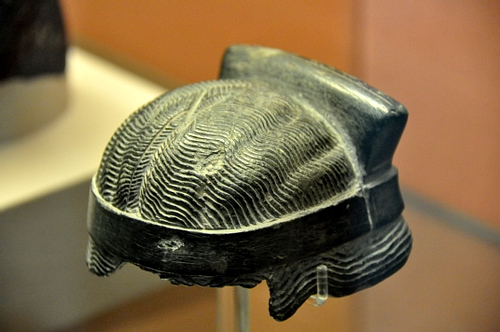
This peaceful and prosperous version of Shulgi's administration, however, has been challenged because first, as already noted, the history comes from state-issued documents and, more importantly, later writers claimed that Shulgi had purposefully falsified those documents to present himself as the greatest of the kings of Mesopotamia.
The same chronicles which present the king as divine also state that “Shulgi, the son of Ur-Nammu, provided abundant food for Eridu, which is on the sea shore. But he had criminal tendencies and the property of Esaglia and Babylon he took away as booty […] caused to consume his body and killed him” (CM, Tablet A, 20:28-30). Another passage from the Chronicles claims that during Shulgi's reign he “composed untruthful stele, insolent writings, concerning the rites of purification for the gods, and left them to posterity” (CM 27).
Both of these would have been very serious offenses to the Mesopotamian sensibility, of any time in the region, which held the accurate recording of the past a matter of enormous significance. The claim that Shulgi took the property of the Esaglia (the temple) at Babylon is serious enough, since the temple goods belonged not to the particular city but to the god of that city, but then to lie about it in written form and present these lies as genuine history would have been intolerable.
The Mesopotamian Chronicles (also known as the Babylonian Chronicles) are a history of the activities of the kings of Mesopotamia compiled by scribes at some point in the 1st millennium BCE from older sources. While scholars have long believed they were composed at Babylon, there is reason to believe they were assembled at different sites by different scribes under the direction of the Assyrian Empire, probably by King Ashurbanipal (r. 668-627 BCE) at Nineveh.
It is entirely possible, even quite likely, that these later scribes, writing from a certain point of view and wishing to advance their own agenda, edited or omitted certain details from the past in composing the chronicles, but it is unlikely that they would have completely fabricated incidents and passed them off as history. Most likely, they were drawing on the tradition of Mesopotamian Naru Literature which took "factual" information and embellished upon it for effect in order to transmit central cultural values - such as admiration for, and obedience to, the king.
The reference to Shulgi's sack of the Esaglia of Babylon implies that Babylon rose in revolt during Shulgi's reign – an event left unrecorded in his administration's documents – and, if this did happen, it is probable that other regions of his kingdom also held Shulgi in less esteem than the official state records claim. Babylon was a city as famous in Mesopotamian history for rebelling against outside rule as it is in the Bible for depravity. If any city under Shulgi's rule was going to rebel, it would have been Babylon and although the sacking of any temple was considered a serious crime, the sacking of the Esaglia of Babylon seems to have been regarded as the worst. Later kings, such as the Assyrians Tukulti Ninurta I and Sennacherib, were assassinated for their impiety in defiling the temple of Babylon and this may have been Shulgi's fate as well.
The Great Wall & the Death of Shulgi
Toward the end of his reign, Sumer was becoming increasingly troubled by incursions from the nomadic tribe known as the Amorites. Shulgi had a wall constructed 155 miles long (250 kilometres) along the eastern border of his kingdom to keep the Amorites out but, as it was not anchored at either end, the invading nomads could simply walk around it. The Elamites were also at the border but, during Shulgi's reign at least, were kept at bay by the army of Ur fortifying the wall.
After reigning for 46 years, Shulgi died and was succeeded by his son Amar-Sin (r. 1981-1973 BCE) who defeated the Elamites and strengthened the wall. He was succeeded by his younger brother Shu-Sin (r. 1972-1964 BCE) who devoted further efforts to the wall, put down revolts by Amorite communities that had established themselves in the kingdom, and tried to emulate the reign of his father and maintain the dynasty. He was succeeded by his son Ibbi-Sin (r. 1963-1940 BCE) who steadily lost the territories of the kingdom built by Ur-Nammu and Shulgi. Kriwaczek comments:
In spite of all efforts to strengthen it, the wall was not enough to keep the western barbarians at bay. They continued their raids, adding to the travails of the failing empire. (161)
Ibbi-Sin was the last king of the Third Dynasty of Ur and, by the end of his reign, the vast kingdom was reduced to only the city of Ur which later fell to the Elamites.
Shulgi's death is as controversial a topic as the records which describe his reign. Scholars continue to repeat sentences such as “Shulgi may have died violently from an assassin's blow, along with his consorts Geme-Ninlila and Shulgi-Shimti” (Bertman, 105) or “Shulgi may have died a violent death in a palace revolt” (Leick, 160) but it is uncertain whether this claim is valid. The primary suspects alluded to by modern-day scholars are always Shulgi's sons but, in order for them to have assassinated their father and then assumed rule after him, they would have needed some kind of support from the officials of the court, their family, or by reading the discontent of the people and hoping for popular support for a coup.
The scholar Piotr Michalowski has confirmed that Shulgi-Shimti was still living after Shulgi's funeral and that, “A text dated a month after the monarch's demise mentions a delivery of cattle from [Geme-Ninlila's] herd, but this does not tell us if she was alive or dead” (290). Shulgi-Shimti was Shulgi's wife, and it is documented that she wielded considerable influence at court. Geme-Ninlila was Shulgi's concubine but also held a position of honor at court and was a successful businesswoman in her own right.
There is no evidence that the tide of popular opinion had turned against Shulgi or that there was any plot launched by the members of the court. Shulgi's supposed assassination is suggested by the Mesopotamian Chronicles which links his alleged sack of the Esaglia of Babylon with his death. As previously stated, later kings during the Assyrian period of Mesopotamian history are known to have been murdered by their sons for this very crime against the gods, and perhaps later Assyrian and Babylonian writers interpreted Shulgi's story in light of what they knew of their own history.
It is also possible that the missing section of that passage stated something which would support a very different understanding of Shulgi's death. Shulgi may have been assassinated for his crimes against the gods or may have died a natural death, but the repeated assertion that his queen and consort were assassinated with him cannot be supported, and the claim that he was killed by his sons is equally untenable.
Conclusion
While the state records which documented his reign have been challenged, the archaeological evidence from the period supports their claims that Shulgi's reign was indeed prosperous and that the accomplishments he claimed for himself did happen, even if not exactly as described. Under his reign the roads were improved, the kingdom expanded, the economy was strong, the inns were built, the calendar and time were standardized, as were weights and measures, and literacy and the arts flourished.
Whether he was guilty of fabricating aspects of his life and reign is still debated, but there can be little doubt that he was a man of enormous administrative and military talent, imagination, determination, and personal charisma. One may question whether he deserves the title he still holds as the greatest king of the Ur III Period but, when one measures his accomplishments against his deficiencies, the former outweigh the latter, and there were certainly no kings of the period following him who were in any way his equal.
